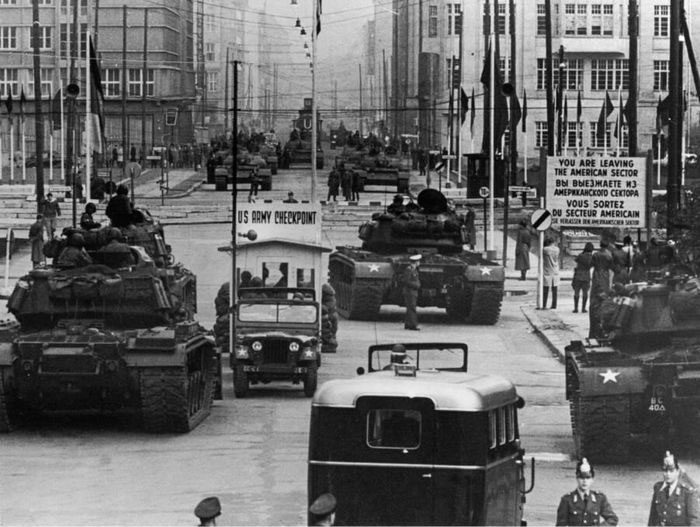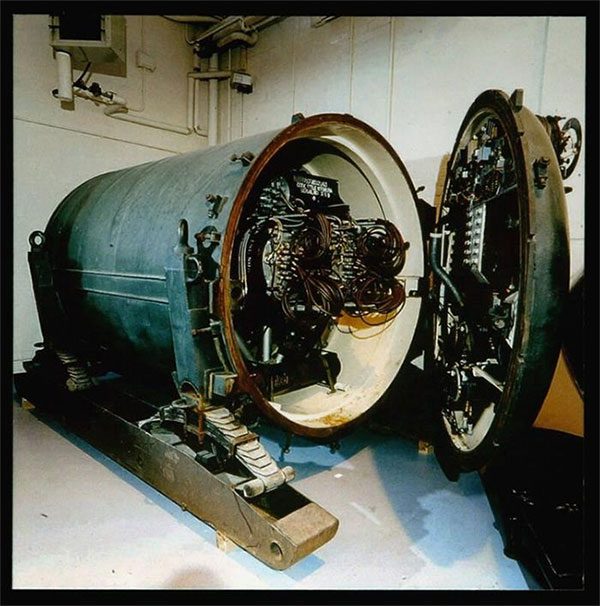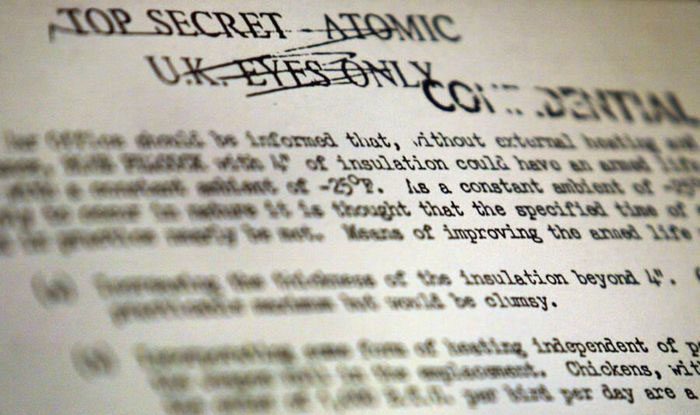According to All That’s Interesting, when the Iron Curtain formed across Europe after World War II, nations on both sides began planning for what to do if the Cold War escalated. As the nuclear arms race commenced, the British devised a top-secret plan known as Operation Blue Peacock to prevent what they believed could be a Soviet attack.
The British plan involved burying nuclear mines across West Germany to detonate if the Soviets attempted to invade. The problem with these nuclear mines was that cold weather could prevent them from exploding.
The solution they proposed was to keep live chickens inside the buried mines to keep them warm. This may sound bizarre and hard to believe, but Blue Peacock was indeed a real operation.
The Cold War Sparks a Nuclear Arms Race

Tanks in Berlin. (Photo: US Army).
World War II ended in 1945, but a new confrontation soon enveloped the globe. This time, the conflict involved nuclear powers against one another.
In the 1950s, the North Atlantic Treaty Organization (NATO) faced off against the Warsaw Pact, with Germany as a zero-sum battleground. Divided after World War II, this nation became a hotspot where the Cold War could easily heat up.
The question was how far each side would go to secure victory. For their part, the British were willing to use nuclear weapons. In the early 1950s, according to The Guardian, the British Army proposed a bold idea codenamed Blue Peacock.
The British Royal Armament Research and Development Establishment (RARDE) explored numerous ways to deter the Soviets with nuclear weapons, but the Blue Peacock project involved something rather unusual: atomic mines.
RARDE suggested burying mines in the northern plains of Germany. If the Soviets entered Western territory, the British would patiently wait for them to establish a command base and supply depot, then detonate the mines right beneath them.
These mines were not small either. With a yield of 10 kilotons, each mine was as powerful as half of the atomic bomb that devastated the city of Nagasaki in Japan in 1945 and would leave a crater larger than a football field on the surface when detonated. Following the explosion of the nuclear mine, vast areas of Europe would be engulfed in radioactive dust.
In addition to destroying Soviet forces, the British hoped that the nuclear mines would render it impossible for the Soviets to establish a foothold due to the radioactive contamination driving them out of Germany.
According to a top-secret policy document from 1955, a cleverly positioned atomic mine would not only destroy facilities and structures over a wide area but also prevent the enemy from occupying the area for a significant period due to radioactive contamination.
However, despite initially seeming like a promising weapon, the Blue Peacock project also had several flaws that engineers needed to address.
The Nuclear Bomb Heated by Chickens

Prototype of a nuclear mine. (Photo: Getty Images).
One of the first challenging situations the British faced was how to trigger these new mines. According to Popular Mechanics, one option was to hastily bury each mine set with a timer for 8 days if Soviet forces began to advance.
Officials also considered remotely activating the nuclear mines or programming them to explode within 10 seconds if they were disturbed. However, another issue remained: the weather. Temperatures often dropped below freezing in northern Germany during winter, especially underground. Due to the numerous complex components, the mines could malfunction if the temperatures were too cold.
Initially, engineers proposed wrapping each 7-ton mine in fiberglass blankets to keep them warm, but then they came up with a different idea: using chickens. Live chickens would be placed inside each mine casing with just enough food to last them for 8 days. The body heat of the chickens would keep the mines warm until they detonated. Of course, the chickens would die in the explosion if they didn’t starve first.
It sounds strange, but engineers actually built two prototypes, and the British Army even ordered 10 atomic mines in 1957. However, the design was never put into operation.
The End of Operation Blue Peacock

A top-secret document explaining the plan to use chickens in nuclear mines. (Photo: Getty Images).
The British labored over the Blue Peacock project for four years before abandoning it. In 1958, the British Ministry of Defence cancelled the project, which was deemed politically flawed. They were concerned about radioactive dust and the devastation it could cause to allied territories.
Researcher Lesley Wright stated, “By today’s standards, that weapon seems odd, but it was a product of its time.”
Even after the plan was canceled, Blue Peacock remained a secret for many decades. In fact, it wasn’t until 2004 that the project was declassified. The information was released on April 1st of that year, leading many to wonder if it was some sort of bizarre April Fool’s joke.
Some people believed Blue Peacock was such an elaborate hoax that Tom O’Leary, director of education at the National Archives, had to issue a statement affirming, “It sounds like an April Fool’s joke, but it certainly is not. The Archives are not joking.”


















































